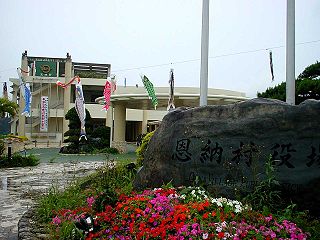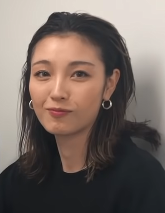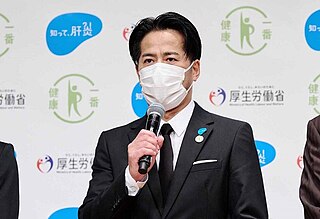
Fukui Prefecture is a prefecture of Japan located in the Chūbu region of Honshū. Fukui Prefecture has a population of 778,943 and has a geographic area of 4,190 km2. Fukui Prefecture borders Ishikawa Prefecture to the north, Gifu Prefecture to the east, Shiga Prefecture to the south, and Kyoto Prefecture to the southwest.

Onna is a village located in Kunigami District, Okinawa Prefecture, Japan.
The dakuten, colloquially ten-ten, is a diacritic most often used in the Japanese kana syllabaries to indicate that the consonant of a mora should be pronounced voiced, for instance, on sounds that have undergone rendaku.

Hiroshi Abe is a Japanese model and actor. He is known for his roles in TRICK and Godzilla 2000: Millennium.

Japanese pitch accent is a feature of the Japanese language that distinguishes words by accenting particular morae in most Japanese dialects. The nature and location of the accent for a given word may vary between dialects. For instance, the word for "river" is in the Tokyo dialect, with the accent on the second mora, but in the Kansai dialect it is. A final or is often devoiced to or after a downstep and an unvoiced consonant.

The Battle of Bun'ei, or Bun'ei Campaign, also known as the First Battle of Hakata Bay, was the first attempt by the Mongol-led Yuan dynasty of China to invade Japan. After conquering the Japanese settlements on Tsushima and Iki islands, Kublai Khan's fleet moved on to Japan proper and landed at Hakata Bay, a short distance from Kyūshū's administrative capital of Dazaifu. Despite the superior weapons and tactics of the Yuan forces, those that disembarked at Hakata Bay were grossly outnumbered by the samurai force; the Japanese had been preparing, mobilizing warriors and reinforcing defenses since they heard of the defeats at Tsushima and Iki. The Japanese defenders were aided by major storms which sunk a sizable portion of the Yuan fleets. Ultimately, the invasion attempt was decisively repulsed shortly after the initial landings.

Jien was a Japanese poet, historian, and Buddhist monk.
Junko Miyashita is a Japanese actress who had a long and varied career working both in pink film and mainstream cinema.
The Saga dialect is a dialect of the Japanese language widely spoken in Saga Prefecture and some other areas, such as Isahaya. It is influenced by Kyushu dialect and Hichiku dialect. Saga-ben is further divided by accents centered on individual towns.

The Miss Nippon Contest is a Japanese beauty pageant. In the past 57 competitions, the total number of applications is 118,794 people and the Grand Prix is 55 people. It started in 1950 by the Yomiuri Shimbun and is held every year by the "Miss Nippon Association".
The bibliography of Kimitake Hiraoka, pen name Yukio Mishima, includes novels, novellas, short stories and literary essays, as well as plays that were written not only in a contemporary-style, but also in the style of classical Japanese theatre, particularly in the genres of noh and kabuki. However, although Mishima took themes, titles and characters from the noh canon, he included his own twists and modern settings, such as hospitals and ballrooms, which startled audiences who were accustomed to the long-settled originals.

Yukina Fujimoto, known by her maiden name Yukina Kinoshita, is a Japanese model, actress, and television personality. She was a member of the musical group Pabo alongside Mai Satoda and Suzanne, all three of whom were later grouped with Shuchishin as members of Aladdin.
Yuki Kubota is a Japanese actor and model whose work has included stage, television and film roles. He is best known as the character Takatora Kureshima / Kamen Rider Zangetsu / Kamen Rider Zangetsu Shin in the Kamen Rider series Kamen Rider Gaim. He is currently affiliated with the Japan Music Entertainment agency.
Yukio Shige is a retired Japanese police officer and head of an NPO that works to prevent suicides at the Tōjinbō cliffs in Fukui Prefecture in Japan. His work and that of the NPO is believed to have saved over 750 lives. He is known as the "chotto matte" man, for the words he says to people considering suicide.

Hiroyuki Igarashi is a Japanese dancer and producer. He is the leader of Exile and the creative leader of LDH World.
Kento Kaku is a Japanese actor born in Tokyo. He has appeared in a number of feature films, television series, and stage productions. He is represented by Amuse, Inc. His wife is actress Nana Eikura.
Mio Imada is a Japanese actress and model from Fukuoka. Imada began her acting and modelling career in 2015 after being labelled “Prettiest Girl in Fukuoka” by a local advertising agency. Her acting big break was in 2018 when she was cast as Airi Maya for notable Japanese drama series Boys Over Flowers Season 2.

Don't Call It Mystery, also known as Do Not Say Mystery, is a Japanese manga series written and illustrated by Yumi Tamura. It has been serialized in Shogakukan's josei manga magazine Monthly Flowers since November 2017. A television drama adaptation was broadcast on Fuji TV from January to March 2022.
Shin-ichiro Tomie is a Japanese game director, writer and part of Spike Chunsoft's affiliation. Since 1995, he contributes to the company with the Mystery Dungeon franchise as the main writer for the Shiren the Wanderer, and Pokémon Mystery Dungeon series. Prior to his affiliation to the company in 1992, he has also contributed in Tecmo's Tecmo Bowl series of sport games.
Royal Space Force: The Wings of Honnêamise, written and directed by Hiroyuki Yamaga, was the 1987 debut work of anime studio Gainax. While in creative terms the film was described by its executive producer, president of Bandai Makoto Yamashina, as "pure moviemaking" and having been made "without compromise", its marketing and release plans, under the advertising department of its distributor Toho-Towa, were outside the control of Gainax, and both Gainax and Yamashina acknowledged continuing clashes over these aspects; approximately half of the 800 million yen spent on the film was allocated to advertising and distribution rather than on direct production expenses.

















